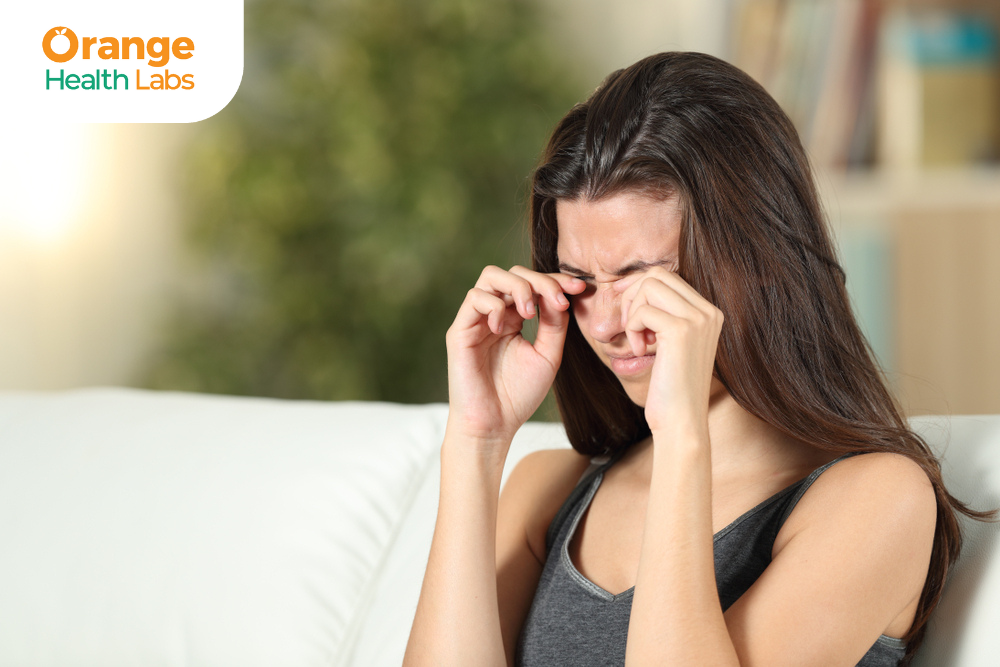Search for tests or checkups
Support8 Causes of Itchy Eyes: Reasons Your Eyes Itch

Itchy eyes are a common symptom worldwide, especially during hay season. That persistent urge to rub and scratch can disrupt your day, leaving your eyes red, watery, and uncomfortable. Scratching can further irritate your eyes and potentially damage them.
Identifying the underlying cause of itchy eyes with the help of an allergy test package is crucial for effective treatment and management.
Understanding Itchy Eyes
Itchy eyes, a frustration for many, can arise from various culprits lurking in your environment or within your body. The eight common reasons your eyes feel itchy are:
- Allergies
- Dry eyes
- Eye infection
- Contact lenses
- Blepharitis
- Airborne irritants
- Eye strain
- Underlying medical conditions
Let’s understand these causes and gain valuable understanding about the source of your itchy eyes.
Causes of Itchy Eyes
- Seasonal Allergies:
Seasonal allergies, caused by the pollen released by trees, grass, and weeds, often lead to itchy eyes. The pollen triggers an allergic reaction of the eyes and causes symptoms such as itchy, watery, red eyes; swelling of the eyelids; and burning sensation in the eyes.
The good news is that itchy eyes caused by seasonal allergies can be managed with the below strategies:
- Avoidance: Check pollen forecasts and try to stay indoors on high pollen count days. Keep windows closed and use air conditioning with air filters.
- Over-the-counter medications: Antihistamine eye drops or oral medications can help reduce inflammation and itching.
- Eyelid hygiene: Cleaning your eyelids regularly with a gentle cleanser can remove pollen and other allergens that may be clinging to them.
- Eyelid compresses: Applying cool compresses to your eyes for a few minutes at a time can reduce inflammation and soothe itchiness.
If your symptoms are severe, don't respond well to over-the-counter medications, or are accompanied by other allergy symptoms like a runny nose or difficulty breathing, consult a doctor.
- Perennial Allergies:
Unlike seasonal allergies triggered by pollen, perennial allergies cause year-round misery. These allergies are caused by exposure to indoor allergens that are present throughout the year, making them a constant source of irritation.
Common triggers for perennial allergies include:
- Dust mites
- Pet dander
- Mould
- Cockroach droppings and body parts
Perennial allergies can also cause itchy, watery, and red eyes, and may be accompanied by other symptoms such as:
- Stuffy or runny nose
- Sneezing
- Coughing
- Nasal congestion
By understanding the triggers and implementing management strategies, you can minimise exposure to allergens and find relief from itchy eyes caused by perennial allergies.
- Airborne Irritants:
Airborne irritants such as the following can cause itchy, red, and watery eyes, making you feel like something is stuck in your eyes:
- Smoke
- Air pollution
- Perfumes and strong odours
- Dry air
The key to managing itchy eyes caused by airborne irritants is to avoid exposure whenever possible. If your symptoms are severe, don't improve with avoidance strategies or over-the-counter solutions, or are accompanied by other concerning symptoms like blurred vision or pain, consult a doctor. They can help identify the cause of your irritation and recommend additional treatment options.
- Infection:
Itchy eyes can also be caused by an underlying eye infection, which will need immediate treatment to prevent complications. Here, we'll explore two common eye infections that can cause itchy eyes:
- Conjunctivitis (Pink Eye):
- This highly contagious infection can be caused by allergies, viruses or bacteria and causes inflammation in the conjunctiva, the thin membrane lining the eyelids and covering the white part of the eye.
- Symptoms: Itchy, red, and watery eyes, along with a feeling of grittiness in the eyes.
- Treatment: Viral conjunctivitis typically resolves on its own within a week, while antibiotic eye drops may be needed for treating bacterial conjunctivitis. Allergic conjunctivitis may be treated with antihistamine eye drops or cold compresses.
- Uveitis:
- This is a less common but more serious inflammation of the uvea, the middle layer of the eye, which can be caused by autoimmune diseases, infections, or injuries.
- Symptoms: Along with itchiness, uveitis can cause light sensitivity, blurred vision, eye pain, and floaters (seeing spots in your vision).
- Treatment: Uveitis requires prompt medical evaluation to determine the cause and prevent vision loss. Treatment may involve corticosteroids, immunosuppressive medications, or antibiotics depending on the cause.
Early diagnosis and treatment of infections are essential for preventing complications like permanent vision damage.
- Dry Eye:
Itchy eyes can also be a symptom of dry eye, a condition where your eyes either don't produce enough tears or the quality of your tears is poor, leading to irritation and discomfort.
Several factors can contribute to dry eye:
- Older age
- Environmental factors such as dry air, wind, air conditioning, and excessive screen time.
- Certain medical conditions, such as Sjogren's syndrome, rheumatoid arthritis, and some eyelid problems.
- Some medications, including antihistamines, antidepressants, and decongestants.
Dry eyes can cause a variety of symptoms, such as:
- Scratchiness
- Burning sensation
- Redness
- Light sensitivity
- Blurred vision
- Watery eyes (ironically, the body's attempt to overcompensate for dryness)
You can soothe dry, itchy eyes with the following methods:
- Artificial tears: These lubricating eye drops can provide temporary relief by mimicking natural tears.
- Warm compresses: Applying warm compresses to closed eyelids for a few minutes at a time can help melt any blockages in the oil glands of your eyelids and improve tear quality.
- Increase humidity: Using a humidifier can add moisture to the air, which is especially helpful in dry climates or during winter months.
- Lifestyle modifications: Limiting screen time, taking breaks from air conditioning, and avoiding smoky environments can all help reduce dry eye symptoms.
- Lid hygiene: Gently cleaning your eyelids with a solution recommended by your doctor can remove debris and improve tear function.
- Prescription medications: In some cases, your doctor may prescribe stronger medications, such as cyclosporine, to increase tear production.
If these solutions don't provide relief, consult a doctor to discuss treatment options to prevent complications like corneal damage or vision problems.
- Eye strain:
Eye strain is a common condition caused by focusing your eyes on a closed object for a long period. This can be caused by using digital devices like computers, smartphones, and tablets, or by reading for extended periods.
Here are some tips for preventing eye strain:
- Follow the 20-20-20 rule: Every 20 minutes, look away from your screen and focus on an object 20 feet away for 20 seconds. This will help to relax your eye muscles.
- Adjust the lighting: Make sure your workspace is well-lit but avoid glare from overhead lights or windows, and adjust the contrast and brightness of the computer screen to prevent eye strain.
- Take breaks: Get up and move around every 30 minutes or so. This will help to improve your circulation and prevent eye fatigue.
By following these tips, you can help to prevent eye strain and keep your eyes healthy.
- Contact Lens Use:
Contact lenses are a great vision correction option, but they require proper care to avoid complications. Here's a breakdown of the risks associated with improper contact lens use:
- Eye Infections: Lenses can trap bacteria, fungi, and other microorganisms that can lead to infections. Poor hygiene, sleeping with the lenses on, and using expired solutions all increase this risk. Infections can cause pain, redness, blurred vision, and even permanent eye damage.
- Corneal Ulcers: These are open sores on the cornea, the clear dome at the front of your eye. They can be very painful, are caused by infection or injury from a poorly fitting lens, and can lead to vision loss.
- Neovascularisation: This is the growth of blood vessels into the cornea, which can be caused by prolonged wear of low-oxygen permeable lenses and can affect vision.
Following your eye doctor's instructions for lens care and replacement is essential for maintaining healthy eyes and good vision.
- Blepharitis:
Blepharitis is a common eye condition characterised by inflammation of the eyelids, specifically around the base of your eyelashes.
Symptoms of blepharitis other than dry eyes include:
- Red, itchy, or burning eyelids
- Crusty or flaky buildup on the eyelashes, resembling dandruff
- Feeling like something is in your eye
- Sensitivity to light
- Blurred vision
- Watery eyes
- Increased eyelash loss
There is no cure for blepharitis, but treatments can help manage symptoms and keep flare-ups under control. The mainstay of treatment involves good eyelid hygiene practices like:
- Warm compresses
- Eyelid scrubs: Gently massage your eyelids with a diluted baby shampoo or a commercially available eyelid cleanser to remove debris and bacteria.
- Warm soaks: After applying warm compresses, soak a washcloth in warm water and hold it gently against your closed eyelids for a few minutes.
Management and Treatment
Itchy eyes are a common eye problem that can be associated with some serious underlying conditions. Seeking professional help for itchy eyes is essential for identifying the cause, preventing complications, and addressing any underlying conditions.
Treatment Approaches – Individualised Care is Key:
- Address the cause: The most effective treatment will target the underlying cause of your itchy eyes. For example, allergy medications for allergies, antibiotics for infections, or artificial tears for dry eyes.
- Allergy Testing: If allergies are suspected, allergy testing can pinpoint specific triggers like pollen, dust mites, or pet dander. This allows for targeted avoidance strategies and allergy medication use.
Home Remedies: Alongside prescribed treatments, certain home remedies can provide comfort. These include:
- Apply cool compresses to soothe irritation.
- Use a humidifier to add moisture to the air; this is especially helpful for dry eyes.
- Avoid rubbing the eyes, which can worsen the itchiness and irritate them further.
- Practice good eyelid hygiene, particularly if blepharitis is a concern.
There's no one-size-fits-all solution for itchy eyes. A doctor will develop a personalised treatment plan based on your specific diagnosis and medical history.
Book a allergy test package in your city: Allergy Test Package in Noida | Allergy Test Package in Bangalore | Allergy Test Package in Mumbai | Allergy Test Package in Hyderabad | Allergy Test Package in Gurgaon | Allergy Test Package in Faridabad | Allergy Test Package in Delhi
Conclusion
Itchy eyes can be caused by various factors, including allergies, dry eyes, infections (blepharitis), irritants, and even eye strain. The key to managing itchy eyes is identifying the cause. This might need allergy testing, followed by targeted treatments like medication or avoiding triggers. Home remedies like cool compresses and eyelid hygiene can also provide relief. Don't wait for itchy eyes to resolve on their own, especially if symptoms persist or worsen. Seek professional help, and get yourself screened for allergens with the respiratory allergy package. A timely diagnosis and proper treatment plan will ensure your comfort and keep your eyes healthy.

Full Body Checkup and Women’s Health: Special Considerations

The Hidden Link Between Childhood Obesity and Serious Health Issues
